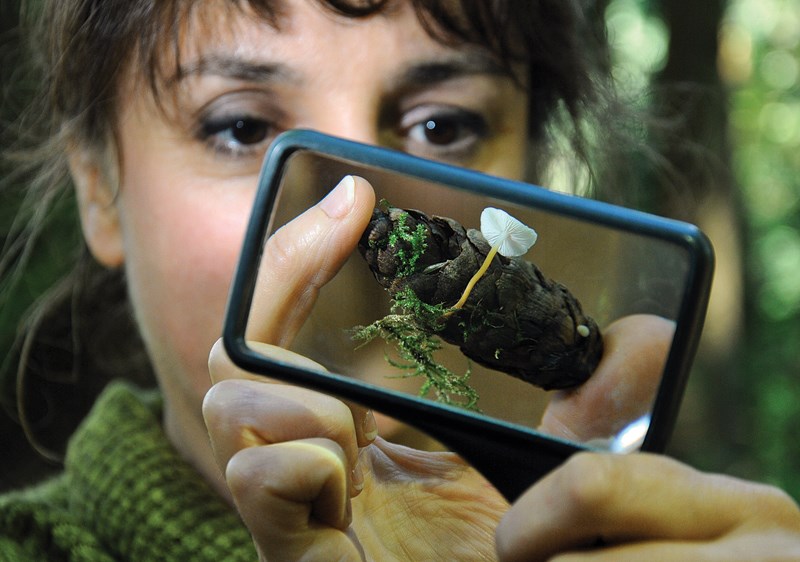Look around the base of a tree, along its trunk, or on a decaying log and you’ll find them.
Puffballs, elfin saddles, witches’ butter, and other types of fungi with equally peculiar names are popping up like, well, mushrooms this time of year on the North Shore.
Every fall, UBC mycologist Mary Berbee leads a fungal tour through Lynn Canyon Park and teaches people about the diverse array of forest mushrooms. This year, the nature walk takes place Sunday, Oct. 2. It’s early in the season, Berbee says, but the conditions are ripe.
“We’ve had more rain than usual across the summer and distribution of the rain has been really good,” she says, explaining that water is essential for a pinhead-sized primordium to grow into a full-sized mushroom with a cap and stalk. “Without the water, they just can’t develop.”
Meanwhile, the trees need to have had a good summer of photosynthesis because, in many cases, they supply the sugars needed for fungal growth.
“What they’ll do in fall is they’ll translocate the sugars down to their root systems and the fungi, which are often partnering with those trees, can use the sugars in the roots to build a complicated three-dimensional fruiting body,” Berbee says.
On next weekend’s walk, she’ll talk about what makes a fungus a fungus, how fungi reproduce, how to identify different types of mushrooms, and which ones are edible and which ones aren’t.
“When it comes down to it, mushrooms, on average, aren’t poisonous that much more frequently than, say, plants, but there are some that are deadly and there are quite a few that would give you a stomach ache and I’ll certainly point those out,” she says.
One famously toxic mushroom hikers might see is the fly agaric (amanita muscaria). With its iconic red cap and white spots, this toadstool looks like it came straight out of a fairy tale book. Eating one would be an “unpleasant experience” though, Berbee says.
“It has components that will make you sick to your stomach for sure, and it may or may not have hallucinogenic compounds as well.”
Meanwhile, there are plenty of edible mushroom varieties that live in our local woods.
“This isn’t going to be a chance for people to collect for the table, but we’re likely to see some things that would be edible. It’s a little bit early for chanterelles, but we may very well find a couple of those and they are edible and delicious and also just beautiful.”
Tricia Edgar, education programmer at Lynn Canyon Ecology Centre, says people joining next weekend’s tour should expect to admire, but not pick, the mushrooms.
“We don’t encourage people to harvest in the park, so it’s more an informational walk about what is edible, what is not,” she says. “Sometimes we do have people who come through the park doing bulk harvesting of mushrooms and it can really impact the mushroom population.”
For those who do forage for wild mushrooms where the practice is permitted, Edgar warns of inedible “look-alike” varieties that could cause upset stomachs if ingested. That uncertainty around edibility, though, is one reason she finds mushrooms so intriguing.
“I think people find them quite mysterious because of the edibility, because of the fact that some of them are poisonous they have that element of danger to them,” Edgar says.
For Berbee, fungi and mushrooms are endlessly fascinating.
“It’s almost like magic,” she says. “Something that you don’t anticipate all of a sudden is abundant and diverse and the colours and shapes and sizes of the mushrooms in fall in Lynn Canyon is just amazing.”
Berbee says it’s interesting to note that a mushroom is actually the spore-bearing fruit of a fungus that lives unseen most of the time.
“One thing that fascinates me is that you see the fruiting bodies during the fall, but the actual fungus is there all year round and it’s important ecologically because it’s helping the plants get nutrients and it’s breaking down some of the woody and brushy debris,” she says. “The fungi, when you can’t see them, are ecologically really important – much more important than when you can see them.”
The Elfin Saddles and Witches’ Butter Mushroom Walk takes place Sunday, Oct. 2, 1-2:30 p.m. starting at Lynn Canyon Ecology Centre. Cost: $8.25. For ages 15 and up. Call 604-990-3755 to register.



